
We are proposing a low-cost and low power wide-area sensor network that will quickly alert the authorities in case of a forest fire. The project will utilize a mesh network of low-power LoRa transmitter nodes connected to Temperature sensors. The network will be inactive until the temperature at any one node goes above a programmable specified limit, in which case the particular node will send an alert to the FPGA through the network. The FPGA will decide if the alert is real based on fire data modeling of the sensors and alert the authorities with the exact location of the fire.
Demo Video
Project Proposal
1. High-level project introduction and performance expectation
Forest fires present a severe problem in the world today. Not only do they result in loss of flora, fauna and human lives, they also cost us billions in property damages and disaster containment efforts each year. In the past year alone, fires across California resulted in the loss of 4.2 million acres of thriving biodiversity. With the devastating effects of climate changes being felt worldwide, it is imperative that we take care of our forests and the varied biomes that they encapsulate.
With the recent advances in low-power, low-cost computation machines, it has become easy to monitor large swathes of an area with a Widespread sensor network. Here, we propose a novel technique involving a central FPGA and regularly spaced intelligent micro-sensor nodes that form a network throughout the forest. The system will monitor the forest conditions and serve as an early warning about a possible fire.
Our proposed system has the following characteristics:
The forest will have sensor nodes spaced at calculated intervals. These nodes will be equipped with ultra-low-power LM335 temperature sensor, a ESP32 microcontroller with a wake-from-sleep functionality and a LoRa transmitter built into it. Lithium ion batteries will power all the nodes.
The nodes will be within the transmission range of another similar node. In the event of a fire, the on-board Microcontroller will decide if the alert is real based on the gradient of the temperature data as compared to a calibrated threshold. If the MCU decides that it is a real fire, it will alert all of its neighbors using the LoRa transmitter.
Upon reception of a fire alert, the nearest neighbors will capture temperature and humidity data from their own sensors and pass it along with the alert to the sensor network. Thus, the fire alert and the sensor data from the original node and its neighbors will form an important data point for the central FPGA computer to decide if it is a false alert. Each sensor node has a unique ID, and the central FPGA can pinpoint where the alert originated.
All the sensors will be connected in a mesh network, and the presence of nearest neighbors ensures that a fire alert is relayed to the network, even in the case of a node malfunctioning.
The Intel FPGA computer will sit at the edge of the forest and will perform the most critical function- deciding if the alert is false or not. This will be determined using multiple data points available to the FPGA: sensor data from the node issuing the alert, data from neighboring nodes, previous true and false alerts data and data from sophisticated particulate and gas sensors available to the FPGA on site. The FPGA will continuously monitor alerts from an aging sensor network and dynamically decide if the authorities should be alerted of a possible fire. We will use a regression model for this, and the model parameters will be stored in the on-board memory.
The FPGA will build a decision model based on the past alerts information that is logged on it. In this manner, even if the sensor readings start deviating after a long time of operation, the decision model can be tweaked to make sure that false alerts and minimized.
A good approach to a quick validation of an alert would be drones stationed at the periphery of the forest, connected to the cloud, at regular intervals. If the FPGA decides that the fire alert could be accurate, it will relay a request to the drone closest to the alert location to verify the fire event visually.
2. Block Diagram
3. Expected sustainability results, projected resource savings
System sustainability for long-term operation will depend on minimizing human intervention in terms of maintenance and false alert validation. This is done in our system while ensuring reliable performance by taking care of the following parameters:
Low power
Minimizing false alerts
Built-in redundancy
Sustainability and key performance parameters:
We can evaluate the lifetime of the Sensor system using these calculations:
Sleep mode current of a sensor node ~ 10µA
Rx current 10mA
Data polling interval: 120s / 2min
Battery capacity: 2AA batteries, ~4000mAh
Sequence of operations: The sensor node will periodically (every 120s) wake from deep sleep, poll the temperature sensor reading, will check the RX channel for any incoming transmission for 10s, and then go back to deep sleep.
The average current consumption of the sensor node is:
(50mA*30s+10µ*120s)/120s≈25mA
Thus, a sensor node will consume 25mA of current on an average. We will be using an ESP32 Transciever alongwith an SX1276 LoRa Transciever in our design.
According to our tests, a sensor node can transmit upto 20m in dense urban environment. A detailed calculation of the node coverage is given in subsequent sections.
Statistics show that 85% of forest fires are caused by human errors. This can be used to our advantage. The sensor network will not cover the entire forest area, instead it will only cover areas that are frequented by people. This will include campsites, hiking trails, picnic spots, regions surrounding roads and hunting sites. This will drastically bring down system costs, as the number of sensor nodes can be reduced. Since the sensor network surrounds areas easily accessible to people, maintenance and upkeep of the sensor network will also be easier.
4. Design Introduction
The fire alert system will be completely automated owing to the operation principle of the sensor network. When one sensor node will detect atmospheric changes such as rise in temperature, it will send a signal to its nearest sensor nodes, and that node again to its nearest one. The signal will keep getting communicated further in this way.
>The backbone of this system will be the FPGA. The sensor nodes are delegated the task of looking at sensor data and verifying if it violates a calibrated threshold. The fire alert is relayed to the FPGA, along with the identity of the node which declared the alert, and sensor data from that node and its neighbour. The FPGA will issue and alert and log this information.
>As with any system, malfunctions are possible, and in the case of our system they mean more and more manpower costs to validate false fire alerts. Malfunctions could also mean that some nodes go offline and fire alerts are not issued correctly. These issues are taken care of in the following manner:
>To account for intense weather conditions that may trigger the sensors, all the sensors run calibration cycles to set the fire alert threshold dynamically regularly.
>We will implement a decision model on the FPGA once we get sufficient number of data points from the system. The task of this model is to use the information from the past alerts to indicate the probability of an incoming alert being a false alert.
>This model can be implemented and changed in real time based on incoming fire alert signals using the onboard memory and logic on the FPGA. The reprogrammability and memory storage on the FPGA are a necessary part of this system to make it sustainable in the long run.
>The sensor nodes will alternate between cycles of deep sleep and polling the temperature sensors to check for a fire. The low sleep currents on the ESP32 ensure that the system draws minimum current.
>A unique node ID configured to each node also ensures that pinpointing a fire after an alert is fast and efficient, since we will know the exact place in the forest where the alert is coming from.
>The FPGA will be placed at the location of the Forest rangers' office to make sure that the alerts are routed to the appropriate people in a timely manner.
5. Functional description and implementation
The implementation of the design uses the Intel FPGA, LM335 temperature sensors, ESP32 microcontrollers and SX1276 Lora transcievers. The ESP32 is programmed using Arduino libraries (C++) and the FPGA is programmed using C. The implementation is as follows:
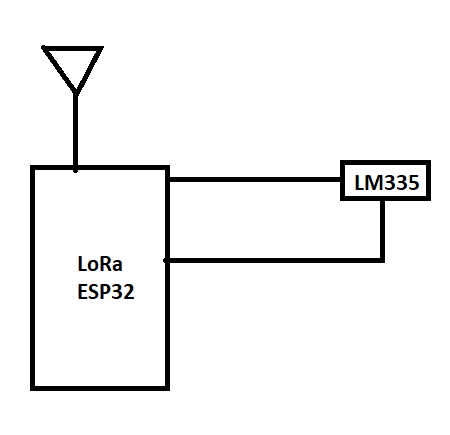
>There are nodes at the edge of the forest and close to the FPGA that can directly communicate an incoming fire alert to the FPGA.
>The rest of the nodes are spread deeper into the forest, spreading out from the FPGA in a tree topology to maximize the amount of ground covered with minimum number of sensor nodes while still ensuring nearest neighbour communication.
>The nodes will alternate between deep sleep and sensor polling/looking for incoming LoRa alerts in an alternating fashion, with a duty cycle of 50%. Since we want to keep the node functionality simple to conserve power, keeping the duty cycles close to 50% mean that no time synchronization mechanisms are required at the nodes, since even highly asynchronous nodes can talk to each other before one of them goes into deep sleep.
>All nodes run calibration cycles by taking a running average of 20 temperature readings at a given time. The calibration cycles are run after a fixed number of cycles that is randomized for every node. The calibration cycles ensure that intense weather and variation in sensor readings over passage of time does not result in false alerts.
>In case of a rare event when a node calibrates during a forest fire initiation, the node will not be able to register the fire and will fail to send out an alert. This is easily remediated since the next nearest neighbour will eventually detect the fire and send out an alert. This is possible because the calibration is run after different number of cycles for each node (randomization). So while the node closest to the fire was not able to detect the fire due to miscalibration, the nearest neighbour will most likely not calibrate itself at this exact same time.
>Once a fire alert is detected by a node, it broadcasts its node ID and its temperature sensor reading over LoRa. The neighboring node sees this and adds its own sensor readings to the packet and relays the message forward. The neighboring node's sensor readings form a crucial additional data point that will help us build a decision model.
>We host a web server on the FPGA using the RFS daughter board's ESP8266. This web page functions as a dashboard for system status information and also functions as a bridge between the FPGA and the sensor network. The nodes close to the FPGA connect to the WIFI access point on the FPGA and use the server to indicate to the webpage if a fire alert has occured. The web server then gives the user the ability to declare if an alert was a true alert or a false one, and logs the node ID, node sensor data and neighboring node sensor data on board.
>Over time, we use the accumulating data points from the on board memory to build a decision model which will tell us accurately if a sensor reading from a particular node warrants a fire alert.
Decision-making using Machine Learning
Forest fires are the cause of massive flora, fauna, and economical losses every year. They also contribute to global warming and endanger human lives. While more than 85% of forest fires are caused by human activities, as has been stated in numerous literatures, multiple meteorological factors contribute to its generation and persistence as well. From different research works, it has been seen that several meteorological factors aid in the generation or persistence of forest fires. The most prominent ones are temperature, relative humidity, precipitation, cloud cover, wind speed, and pressure. Usually, weather is sunny under high pressure, high temperature, low relative humidity, and forest fires are easy to form; conversely, during low pressure, cloud generation is easier, precipitation is more, and forest fires do not start quickly. To understand the level of impact of the meteorological factors, a data analysis study has been undertaken here to quantify those relationships and utilizing those results, build an economical and sustainable early-warning fire alert system that can minimize losses due to forest fires. This Exploratory Data Analysis (EDA) work is utilizing the dataset given by Cortez and Morais (2007), which documents forest fire data from Montesinho natural park, Northeast Portugal. There are 517 entries in the dataset and the studied dataset consists of monthly and daily forest fire count, Fine Fuel Moisture Code (FFMC), Duff Moisture Code (DMC), Drought Code (DC), Initial Spread Index (ISI), temperature, relative humidity, wind speed, rain, and forest area burned by fire. From our data analysis using the above dataset, it was observed that most forest fires occurred in the month of August and on Sundays, followed by Friday and Saturday. Since most forest fires are caused by human activity, so this result may also be linked to that since people often go camping or other activities during weekends. Another important observation was that temperature, month, FFMC, DMC, DC, ISI have strong correlations with each other. A critical inference drawn from our study is that areas burned due to forest fires are the most positively impacted by temperature, which is the reason for our first choice of sensor being a temperature-based one.
Considering the above factors, it is clear that we have multiple independent variables, which would be the meteorological parameters, and one dependent variable, which is the probability of forest fire generation. Thus, for this problem statement, multiple linear regression would be the model of choice for determining the probability of a forest fire with respect to changes in meteorological parameters.
As a part of our future work, the designed and fabricated early fire alert system would be equipped with sensors for checking relative humidity, light intensity, and carbon monoxide level, along with the temperature sensor in operation at present. Data collection would be done by simulating various controlled fire scenarios over a specific area during different day and night hours, taking meteorological variations into account. Then, the collected data would be divided into two groups, for instances of generation and non-generation of fire, using a clustering technique such as K-means. After which, the data would be appropriately divided into training, testing sets, and validation sets and finally fed into our multiple linear regression model for evaluation. After fine-tuning the model for sufficient accuracy, the data points collected at the FPGA after the threshold ratio analysis would be fed into the trained machine learning model. If the model reaches a decision that a fire has been detected, then the webserver homepage and the onboard LEDs will let the nearby forest rangers know that a fire alert has been issued.
6. Performance metrics, performance to expectation
Here, a two-step methodology has been proposed to reach the decision of raising an early fire alert warning. The suggested detection method would be based on a threshold analysis and decision-making utilizing a machine learning algorithm.
Threshold Analysis
Currently, our fabricated system considers the temperature parameter for fire detection, and the changes in temperature during the course of a fire are monitored by the system. While experimenting with the developed system using simulated small fires, it was observed that the LM335 sensor is able to instantly detect a spike in the temperature readings.
This observation has led us to devise a threshold ratio appropriate for our fire detection system, which will be calculated at set time intervals by reading the data value for a period of 30s. A threshold is dynamically defined and calibrated for a sensor once every 10000 cycles. To make sure that all sensors do not start recalibrating at the same time, the number of cycles after which a node is recalibrated is randomly chosen for each node.
If the temperature reading rises more that 50mV above the designated threshold, a fire alert is issued. The dynamic recalibration makes sure that node-to-node variations and local temperature variations do not trigger the network, which would happen if we had a uniform threshold.
Threshold RTH=Rcalibrated+50
Once a sensor is triggered, the LoRa communication channels across the network will be flooded with the fire alert data from the concerned node. Once the alert reaches the FPGA, the FPGA will send back an acknowledgement pulse, which would cause all the nodes to turn off their LoRa broadcasts and go into deep sleep for an hour, to give us time to verify the fire alert. This will also give the node time to recharge its batteries, since keeping the TX channel on takes a significant amount of current. After an hour, all the nodes will wake from sleep and recalibrate themselves.
To summarise our performance metrics, the broad areas analysed were:
Financial
The cost of a sensor node is $26 for the microcontroller plus $1 for the temperature sensor and other miscellaneous components. Each block of 3 sensor nodes can cover ~2580m2 of forest area. Thus, covering a 100 acre forest requires a cost of roughly $13000 for the sensor nodes and $100 for the FPGA. In 2019, forest fires cost the state of California $163 million in suppression efforts.
Sensors
The LM335 temperature sensor is perfect for a low-cost, low-current temperature reading. The sensor can indicate a spike in temperature with a reasonable accuracy while consuming ~1mA of current.
Performance of communication
The RX current consumed by a sensor node is 10mA. The TX current, while 120mA, is insignificant because once a alert has been transmitted and information has been relayed to the network, the TX is shut off. The TX is run only for one wake cycle before resetting to normal operation to ensure that the alert is relayed successfully.
Responsiveness
Since the sensor will need to wake from sleep to take a reading, it would take atmost the time equal to the sleep time of the sensor node to detect the fire. In our design, we have kept the sleep time to 1 minute and wake time to 1 minute. Once a fire is detected, the LoRa network and the asynchronization between sleep schedules will ensure that the signal is sent to the FPGA almost instantaneously.
Performance over time
In order to account for digression of sensor readings over time due to exposure to elements of nature, the nodes will periodically run calibration cycles. The FPGA will also run decision models to verify the claims of the network. Thus, instead of adding functionality at the nodes to adapt to changing weather conditions and exposure over time, we will keep the nodes simple and add this functionality to the FPGA model.
Scalability
The system is extremely scalable. All that is needed to expand the sensor cover is more sensor nodes.
7. Sustainability results, resource savings achieved
FPGA Fault tolerance and reparability - system sustainability in the long run
Since we are targeting long-term operation with minimal maintenance costs, we can take advantage of the reprogrammability of the FPGA to build a fault-tolerant system that repairs itself in the event of soft faults. We utilize the CRC error detection circuitry to detect and correct soft errors and Single-event-upset incidences (SEU). The internal scrubbing feature corrects for any internally occuring soft-errors or bit-flips wherever possible. To recover from a CRC error, the system will indicate that it needs to be reconfigured by the user by driving the CRC_ERROR programmable I/O pin low, after which the nConfig signal will be used to reconfigure the system safely.
Hard implementation of the FPGA model
The FPGA base station would need to alternate between periods of almost no activity at all when there are no fire alerts to periods of intense workload when the decision model is implemented when a fire alert comes in. There will also be periods of model training workloads wherein model weights will be re-adjusted based on newly acquired fire data. The hardware needs for all these workloads are very similar- embedded multiplier elements to perform large-scale matrix multiplication in parallel.
[Ferreira, 2019] propose a hardware-accelerated IP specifically designed for Linear regression models. The Wifi server part of our implementation only utilizes 4% of the resources on the FPGA so we have ample scope to integrate the embedded multipliers and unutilized programmable logic blocks of the FPGA for running regression model training and decision-making.
Past data can be used to decide what times are best for training the model, since an incoming fire alert during the time when the model weights are being re-evaluated might lead to incorrect decisions. We explored the dataset given by Cortez and Morais (2007) to analyze the correlation between different environmental factors and the amount of forest area burnt.
.png)
The data tells us that August, September and March are months with most fire incidents in the dataset. The data also tells us that Sundays and Fridays are most attributed to forest fire activity. The plot tells us the months during which Forest fires are minimum. These periods are best for re-calculating new model parameters to accommodate more sensor data.
The creek fire of 2020 - a case study
To clearly demonstrate the issues targeted by the system and the meaningful, real-world impact of our project, we consider a case study of the 2020 creek fire. The fire started near Shaver lake, and burned down nearly 379,895 acres of forest area. The total costs assosciated with the fire were ~193 million USD.

Although the fire started near shaver lake on 4th September, it exploded in area nearly 4 days later, engulfing a large part of the Sierra National forest. It took nearly 3 months to contain the fire successfully.
Containment efforts began nearly a week later, fed in part largely by satellite images and emission information from NASA. By then, the damage was already done.
We consider the deployment of our system at the Whiskey Falls campground, a few miles away from where the fire actually began. As stated in our design, we cover areas that are frequented by humans- hiking trails, biking trails and camp grounds. Each sensor node is in contact with two of its neighbours to ensure reliability of communications. The deployment map with sensor node locations is shown above.
We have ensured a reliable communication link between sensor nodes upto 20m apart from each other. Using this information, we can calculate the total area spanned by a 2-neighbour network of 3 sensor nodes as follows:
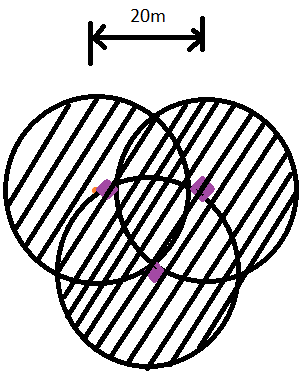
A simple geometric calculation tells us that the total area spanned by the three circles in the figure above is ~2580sq m.
Using a total of ~500 sensor nodes and 1 FPGA base station, we can cover a total of 430600 sq. m of forest area on and around the trails. The total cost of this system would be:
Cost of the sensor nodes : 27*$500 = $13500
Cost of the FPGA base station : $150
Total cost : $13650
Thus, at a mere cost of $13K, we could've not only detected the creek fire of 2020 as soon as it reached the whiskey falls area, but also pinpointed the exact location of the fire for a swift response.
System workflow
The proposed sensor network requires the use of sustainable and reliable battery recharging techniques to ensure long-term operation. A notable option is presented by (Pang et al, 2020) in the form of triboelectric nano-generators which harvest the kinetic energy from the motion of tree branches.
The paper proposes a set of interleaving cylindrical sleeves that interlock with each other and are free to vibrate. The sleeves have copper electrodes that are coated with charged films of PTFE. the relative motion between the sleeves generates a current that can be harvested to charge the batteries of our sensor nodes.
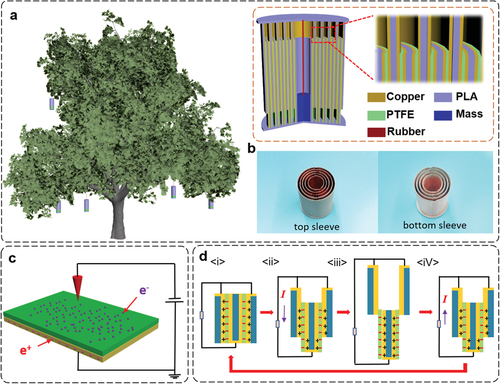
The workflow of the sensor node is outlined below:

The workflow of the FPGA server backend is outlined below:
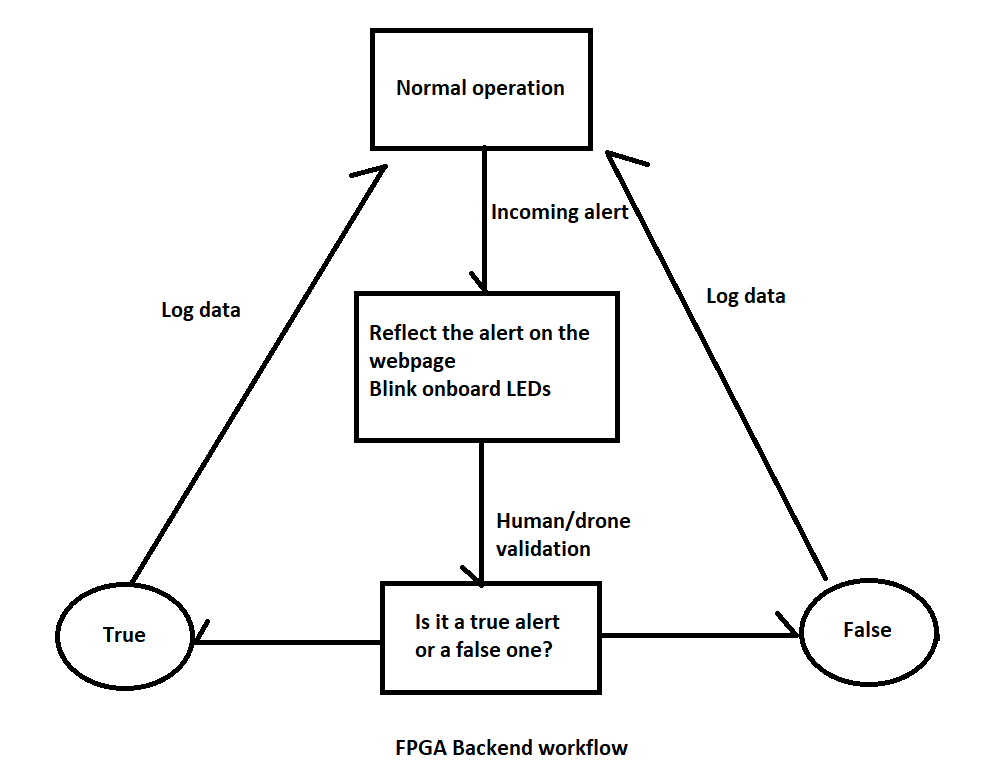
The sensor nodes will be distributed throughout the forest in a tree topology. This will make sure that we cover all the areas frequented by humans in a manner that ensures each node is in contact with two of its neighbors while using minimum number of nodes.
A tree topology is ideal in forests where the trails of human activity branch out in the form of a tree as shown.

Long-term evolution - adding more sensors for better decision making
According to our analysis of the Cortez and Morais (2007) dataset, some climatic and environmental factors show a strong correlation with forest fires. These are temperature, relative humidity and some other meteroogical factors such as the Duff Moisture Code and the Fine Fuel moisture code (FFMC). In the long run, we could add more sensors to the nodes that would give us a more robust system that is better equipped to detect forest fires. The following plot shows the correlation analysis of the various available meteorological factors with each other, as well as with the amount of forest area burnt. We see a clear correlation between temperature and relative humidity with the area burnt, indicating RH sensors as a potential addition to our system in the future.
.png)
The strength of our system is that once we have the infrastructure of the sensor node network, the system not only gets better with time as more data accumulates, but the expansion of the sensor network is as easy as configuring a new node and placing it within the range of an existing node.
8. Conclusion
From data analysis on a real fire dataset, the factors having maximum correlation with forest fires were found to be temperature and relative humidity.
Key features of our designed, implemented, and proposed solutions-
- Efficient
- Quick detection of forest fires
- FPGA makes the system adaptable and reprogrammable
- Reliable system with negligible false alarms
- Economical
- Zero maintenance cost
- Minimal implementation cost
- Estimated implementation cost of 13,650 USD to save ~193 million USD
- Scalable
- Reliable in the long run
- Suggested tree topology can be scaled up very easily
- Built-in robustness and reliability that increases over time
- Sustainable
- Environmentally non-intrusive system
- Millions of hectares of forests can be saved by prompt response
- Proposed fire alert system becomes more technologically sustainable with time due to more data.
- Economically sustainable
- Power and Energy Sustainability- A Multilayered Cylindrical Triboelectric Nanogenerator (MC-TENG) to harvest kinetic energy of tree branches for monitoring environmental conditions and forest fire was developed by a team of researchers at Michigan State University in 2020. They found that a larger vibration amplitude resulted in a higher electrical output. The fabricated system could produce a peak power of 2.9mW and a maximum average power of 1.2mW at a low frequency of 1.25Hz.
Thus, we propose an environmentally friendly system to effectively tackle the issue of forest fires using low-cost technology in a timely manner.
References
Pang, Yaokun 2020, Multilayered Cylindrical Triboelectric Nanogenerator to Harvest Kinetic Energy of Tree Branches for Monitoring Environment Condition and Forest Fire.
P. Cortez and A. Morais. A Data Mining Approach to Predict Forest Fires using Meteorological Data. In J. Neves, M. F. Santos and J. Machado Eds., New Trends in Artificial Intelligence, Proceedings of the 13th EPIA 2007 - Portuguese Conference on Artificial Intelligence, December, Guimarães, Portugal, pp. 512-523, 2007. APPIA, ISBN-13 978-989-95618-0-9.
W. de Assis Pedrobon Ferreira, I. Grout and A. C. Rodrigues da Silva, "FPGA hardware linear regression implementation using fixed-point arithmetic," 2019 32nd Symposium on Integrated Circuits and Systems Design (SBCCI), 2019, pp. 1-6.
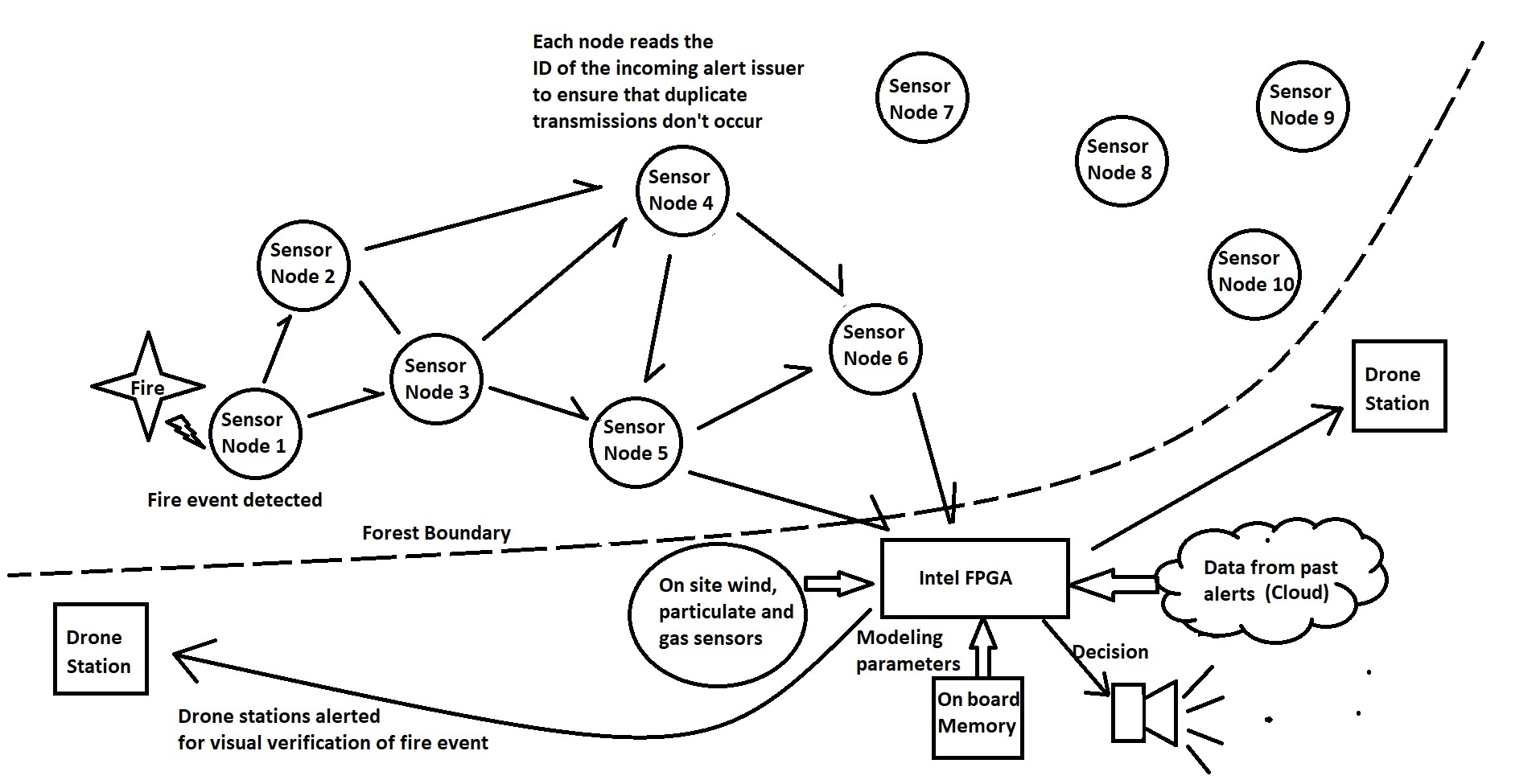
0 Comments
Please login to post a comment.